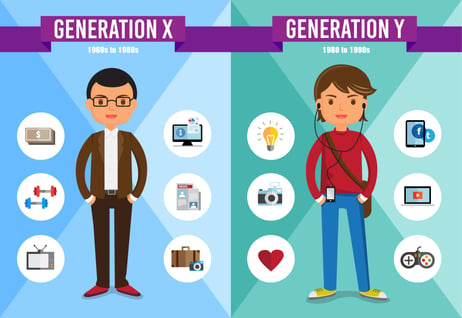"Alone, I am a leaf. Interbeing together with other leaf's, we become a tree. Interbeing together with trees, we become a forest."
In today's rapidly evolving world of work, organizations are faced with the exciting challenge of bringing together a diverse range of generations into their workforce. From Baby Boomers to Generation Z, each generation brings its own unique perspective, values, and work styles to the table. This multigenerational tapestry, when woven together effectively, can be a source of innovation, collaboration, and success for businesses.
As organizations strive to navigate this dynamic landscape, it becomes increasingly evident that building a thriving multigenerational workforce is not just an aspiration but a necessity. It's a journey that requires an understanding of the distinct needs and expectations of each generation, and an appreciation for the common threads that unite them.
To shed light on this critical topic, we embarked on a journey of our own, gathering insights from a community-wide workshop that included over 150 HR executives and people leaders who are shaping the future of work and the employee experience. Our goal was to uncover practical strategies and actions that organizations can take to foster engagement and inclusivity across generations.
Before we dive into the wealth of knowledge we've gathered, let's take a moment to set the stage by exploring the current composition of the workforce and the trends that are shaping our multigenerational workplaces.
Current Workforce Landscape:
As we look at the workforce today, we see a rich tapestry of generations contributing their talents and perspectives. Here's a snapshot of the current generational breakdown in the workforce:
- Baby Boomers: Born between 1946 and 1964, Baby Boomers are still active in the workforce, bringing decades of experience and wisdom.
- Generation X: Those born between 1965 and 1980, known as Gen X, are known for their independent and entrepreneurial spirit.
- Millennials: Born between 1981 and 1996, Millennials, or Gen Y, have emerged as the largest generation in the workforce, with a strong focus on technology and work-life balance.
- Generation Z: The newest entrants, born between 1997 and 2012, are digital natives who value purpose-driven work and diversity.
- Generation Alpha: While not yet in the workforce, Generation Alpha (born 2013 onwards) is growing up in a world of rapid technological change.
Now, let's explore the insights, challenges, and practical steps to building a thriving multigenerational workforce.

Community Discussion #1 - Share one word that comes to mind when you think about a thriving multigenerational workplace.
Key Themes:
- Communication: Many participants emphasized the importance of effective communication in a multigenerational workplace.
- Diversity and Inclusion: Words like "diverse," "inclusivity," and "inclusion" highlighted the significance of having a diverse workforce.
- Flexibility and Adaptability: Terms like "flexibility" and "adjustment to remote work" pointed towards the need for adaptability, especially in changing work environments.
- Empathy and Understanding: Comments like "empathetic," "empathy," and "listening" stressed the need for empathy in interactions between different generations.
- Collaboration and Synergy: Participants recognized the value of collaborative efforts and creating synergy within a multigenerational team.
Key Takeaways:
- A thriving multigenerational workplace requires open and effective communication.
- Diversity and inclusion are crucial for a successful work environment.
- Flexibility and adaptability are essential, especially in the context of remote work.
- Empathy and understanding are vital for positive intergenerational interactions.
- Collaboration and synergy contribute to a thriving multigenerational workforce.
Community Discussion #2 - What strategies or initiatives have you seen implemented in your workplace that effectively foster inclusivity across generations?
Key Themes:
- Mentorship Programs: Several participants highlighted the importance of mentorship programs in fostering inclusivity across generations.
- Training Initiatives: Training on generational differences and related topics were mentioned as effective strategies.
- Employee Resource Groups (ERGs): ERGs were seen as a valuable platform for promoting inclusion activities for employees of different generations.
- Skill-Based Opportunities: Emphasizing skills and experience over age or tenure in job opportunities leads to diverse and multigenerational teams.
- Communication and Listening: Effective communication and active listening were noted as essential for understanding and inclusivity.
- Flexible Work Arrangements: Offering flexibility as a benefit was seen as a way to appeal to a range of generations.
- Reverse Mentoring: Pairing older employees with younger employees to facilitate learning from both perspectives.
- DEI Initiatives: Diversity, Equity, and Inclusion initiatives, including policies, training, and ERGs, were recognized as important in promoting inclusivity.
Key Takeaways:
- Mentorship programs play a crucial role in connecting employees across generations and fostering understanding.
- Training initiatives, particularly on generational differences, are effective in building inclusive workplaces.
- Employee Resource Groups provide a platform for inclusive activities and discussions.
- Emphasizing skills and experience in job opportunities leads to diverse and collaborative teams.
- Effective communication, including listening and seeking understanding, is vital for inclusivity.
- Offering flexible work arrangements and benefits that appeal to different generations contributes to inclusivity.
- Reverse mentoring allows for knowledge exchange between different generations.
- Implementing DEI initiatives, including policies, training, and ERGs, is crucial for creating an inclusive work environment.
Community Discussion #3 - Are there any innovative ways you've seen employee recognition tailored to suit various generations - Is there a specific way your organization does this?
Key Themes:
- Recognition Platforms: Many organizations use digital platforms like Awardco, WorkProud, and RewardsGateway to facilitate employee recognition. These platforms offer various ways to recognize and reward employees.
- Variety in Recognition Methods: Providing a variety of recognition methods, such as awards, letters, videos, and points systems, was noted as important to cater to different preferences.
- Personalization and Self-Awareness: Recognizing individuals where they are, understanding how they want to be recognized, and having self-awareness were highlighted as crucial aspects of effective recognition.
- Gratitude as a Universal Value: Participants emphasized that gratitude is valued across generations, making it an important element in recognition efforts.
- Inclusivity in Recognition: Recognition programs should be organization-wide and not specific to certain groups or generations.
- Flexibility in Rewards: Allowing employees to choose their rewards, such as gift cards or additional time off, was seen as an effective way to make recognition meaningful.
Key Takeaways:
- Digital recognition platforms offer a convenient and efficient way to recognize employees, with various options for rewards.
- Providing a range of recognition methods ensures that different preferences and generations are taken into account.
- Personalizing recognition efforts and understanding individual preferences are crucial for meaningful recognition.
- Gratitude is a universal value that resonates across all generations and should be incorporated into recognition efforts.
- Recognition programs should be inclusive and apply to all employees, regardless of their generational background.
- Allowing employees to choose their rewards adds a level of personalization and meaning to the recognition process.
Community Discussion #4 - Based on what you have heard so far, what is one practical step/action you want to take in your organization to enhance engagement across generations?
Key Themes:
- Reverse Mentoring: Participants emphasized the value of reverse mentoring, where younger employees mentor older employees, as a practical step to enhance engagement across generations.
- Buddy System: Implementing a buddy system was suggested as an effective way to facilitate collaboration and understanding between different generations.
- Encouraging Self-Awareness: Encouraging team members to be self-aware, particularly in understanding their generational perspectives and biases, was seen as important.
- Structured Recognition Programs: Structuring and organizing recognition programs was highlighted, along with educating employees on generational differences and the importance of respect.
- Tailored Recognition: Tailoring recognition efforts to suit the preferences of different generations was identified as a practical action.
- Mentorship Programs: Encouraging mentorship between younger and older generations, as well as adding multigenerational content to DEI training, were suggested strategies.
Key Takeaways:
- Implementing reverse mentoring programs can be a valuable step in fostering understanding and collaboration across generations.
- Establishing a buddy system can facilitate interactions and knowledge sharing between different generations.
- Promoting self-awareness, especially regarding generational perspectives, is important for effective engagement.
- Structuring recognition programs and educating employees on generational differences can enhance engagement efforts.
- Tailoring recognition efforts to suit the preferences of different generations adds a personal touch to the process.
- Encouraging mentorship between younger and older generations and incorporating multigenerational content into DEI training are practical actions to promote engagement.
This feedback reflects a proactive approach to building a thriving multigenerational workforce by leveraging mentorship, fostering self-awareness, and tailoring engagement efforts to suit different generational preferences.
Closing thoughts:
In our journey through the world of multigenerational workforces, we've uncovered a treasure trove of insights and practical strategies. From the importance of mentorship and recognition to the value of self-awareness and tailored engagement efforts, it's clear that organizations have the tools they need to create thriving multigenerational teams.
As we embrace the diversity of generations in our workplaces, we can transform challenges into opportunities and bridge generational gaps with understanding and collaboration. The path to a thriving multigenerational workforce is not just about accommodating differences; it's about celebrating them and using them as a source of strength.
We hope the insights shared in this blog inspire you to embark on your own journey toward building a workplace that thrives across generations. Together, we can create a future of work that's inclusive, innovative, and impactful.
Ready to take the first step? Let's build a thriving multigenerational workforce together.





